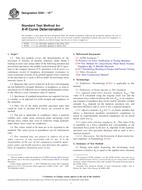Potřebujeme váš souhlas k využití jednotlivých dat, aby se vám mimo jiné mohly ukazovat informace týkající se vašich zájmů. Souhlas udělíte kliknutím na tlačítko „OK“.
ASTM E561-10e2
Standard Test Method for K-R Curve Determination (Includes all amendments And changes 12/24/2015).
Automaticky přeložený název:
Standardní zkušební metoda pro K-R Curve stanovení
NORMA vydána dne 1.11.2010
Informace o normě:
Označení normy: ASTM E561-10e2
Poznámka: NEPLATNÁ
Datum vydání normy: 1.11.2010
Kód zboží: NS-47209
Počet stran: 16
Přibližná hmotnost: 48 g (0.11 liber)
Země: Americká technická norma
Kategorie: Technické normy ASTM
Anotace textu normy ASTM E561-10e2 :
Keywords:
effective crack extension, fracture mechanics, fracture resistance, fracture toughness, KR , K-R curve, linear elastic, plane stress, plastic zone, standard test method, stress intensity factor, ICS Number Code 77.040.10 (Mechanical testing of metals)
Doplňující informace
| Significance and Use | ||||||||
|
The K-R curve characterizes the resistance to fracture of materials during slow, stable crack extension and results from the growth of the plastic zone ahead of the crack as it extends from a fatigue precrack or sharp notch. It provides a record of the toughness development as a crack is driven stably under increasing applied stress intensity factor K. For a given material, K-R curves are dependent upon specimen thickness, temperature, and strain rate. The amount of valid K-R data generated in the test depends on the specimen type, size, method of loading, and, to a lesser extent, testing machine characteristics. For an untested geometry, the K-R curve can be matched with the crack driving (applied K) curves to estimate the degree of stable crack extension and the conditions necessary to cause unstable crack propagation (1). In making this estimate, K-R curves are regarded as being independent of original crack size ao and the specimen configuration in which they are developed. For a given material, material thickness, and test temperature, K-R curves appear to be a function of only the effective crack extension Δae (2). To predict crack behavior and instability in a component, a family of crack driving curves is generated by calculating K as a function of crack size for the component using a series of force, displacement, or combined loading conditions. The K-R curve may be superimposed on the family of crack driving curves as shown in Fig. 1, with the origin of the K-R curve coinciding with the assumed original crack size ao. The intersection of the crack driving curves with the K-R curve shows the expected effective stable crack extension for each loading condition. The crack driving curve that develops tangency with the K-R curve defines the critical loading condition that will cause the onset of unstable fracture under the loading conditions used to develop the crack driving curves. Conversely, the K-R curve can be shifted left or right in Fig. 1 to bring it into tangency with a crack driving curve to determine the original crack size that would cause crack instability under that loading condition. If the K-gradient (slope of the crack driving curve) of the specimen chosen to develop the K-R curve has negative characteristics (see Note 1), as in a displacement-controlled test condition, it may be possible to drive the crack until a maximum or plateau toughness level is reached (3, 4, 5). When a specimen with positive K-gradient characteristics (see Note 2) is used, the extent of the K-R curve which can be developed is terminated when the crack becomes unstable. Note 1—Fixed displacement in crack-line-loaded specimens results in a decrease of K with crack extension. Note 2—With force control, K usually increases with crack extension, and instability will occur at maximum force. |
||||||||
| 1. Scope | ||||||||
|
1.1 This test method covers the determination of the resistance to fracture of metallic materials under Mode I loading at static rates using either of the following notched and precracked specimens: the middle-cracked tension M(T) specimen or the compact tension C(T) specimen. A K-R curve is a continuous record of toughness development (resistance to crack extension) in terms of KR plotted against crack extension in the specimen as a crack is driven under an increasing stress intensity factor, K. 1.2 Materials that can be tested for K-R curve development are not limited by strength, thickness, or toughness, so long as specimens are of sufficient size to remain predominantly elastic to the effective crack extension value of interest. 1.3 Specimens of standard proportions are required, but size is variable, to be adjusted for yield strength and toughness of the materials. 1.4 Only two of the many possible specimen types that could be used to develop K-R curves are covered in this method. 1.5 The test is applicable to conditions where a material exhibits slow, stable crack extension under increasing crack driving force, which may exist in relatively tough materials under plane stress crack tip conditions. 1.6 The values stated in SI units are to be regarded as the standard. The values given in parentheses are for information only. 1.7 This standard does not purport to address all of the safety concerns, if any, associated with its use. It is the responsibility of the user of this standard to establish appropriate safety and health practices and determine the applicability of regulatory limitations prior to use. |
||||||||
| 2. Referenced Documents | ||||||||
|




 Cookies
Cookies
